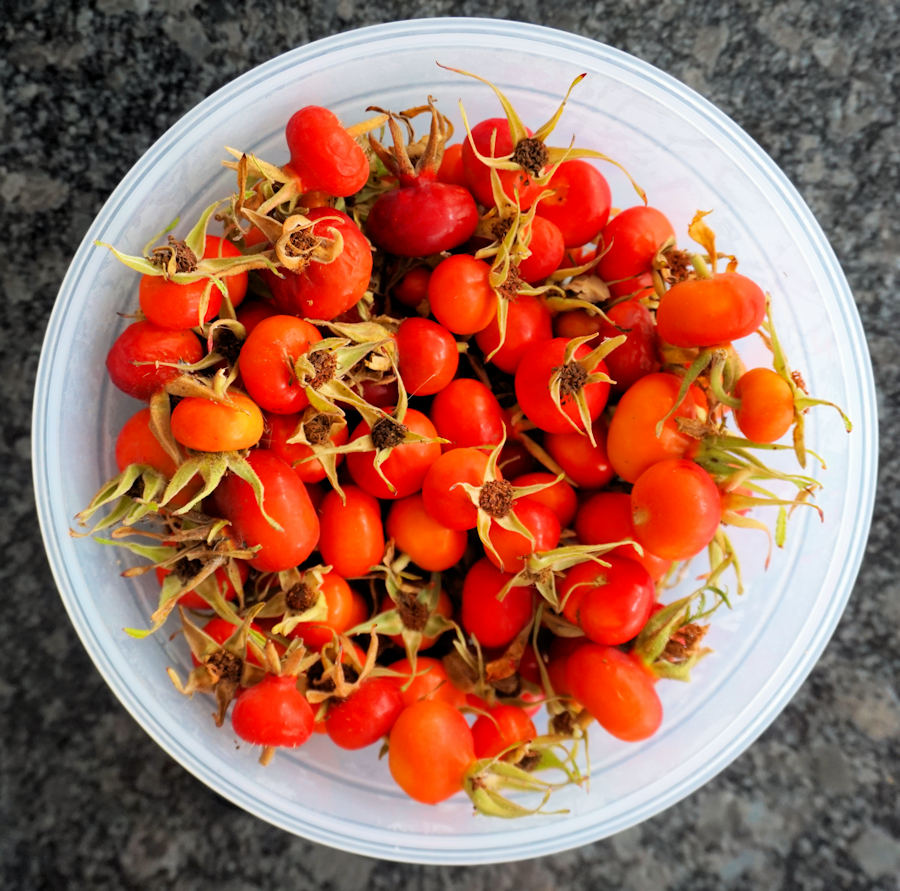Rose is not just a pretty flower. Wild rose blossom turns into fruit called rose hip, and it is a very deliciously jammable material, also full of vitamin C.

Have you ever wondered whether the bright red fruit that appears on the wild rose shrub after it finished blossoming is edible? It is called rose hip and is not only edible: it is a little bright red miracle.
What are the benefits of rose hips?
Rose hips are full of vitamin C. They have analgesic qualities, especially supposed to alleviate osteoarthritis pains. They contain antioxidants, may have anti-aging properties and contribute to fat loss. On top of that, they reduce blood pressure, cholesterol and improve heart health.
Miraculous properties! A minor drawback is that most of that goodness is contained in the seeds which are kind of unpleasant to eat. That’s why the most beneficial form is dried rose hips, brewed into a tisane; or cold pressed rose hip oil.
However, much easier and more satisfying is to make jam from your garden or hedge crop, especially that this processing method will get rid of the tiny hairs that live inside the hips, which may be irritating to your digestive system.
Are rose hips beneficial in jam form?
Most of the antioxidants leech into water during cooking and are lost if that liquid is discarded. Which is not the case while making jam – nonetheless, the heat and length of cooking time will invariably destroy some vitamin C.
But I have realised that my occasional arthritic wrist pain has not troubled me recently, since I started spreading my rose hip jam on toast. Which of course could be either coincidental or a result of self-persuasion. Still, you never know – it might indeed be the rose hip miracle working.
What does rose hip jam taste like?
But what matters most – it is truly delicious.
Contrary to expectations, rose hips don’t have strong rose fragrance; in fact they hardly smell at all. Perhaps in the dried form the scent intensifies?
Hips smell a little like apples when they are cooking, and the jam tastes like a cross between apple and apricot, quite unusual in fact.
Is it jam or jelly?
I am not going to go into the technical intricacies of what makes jam, what makes jelly.
Enough said that this doesn’t have the jelly texture though it is seedless, and it is not as clear as jelly should be. So, jam it is – and jam today!
How to make rose hip jam?
I won’t beat about the (rose) bush: it is quite laborious. And it helps if you have a food mill, the sort of hand-cranked utensil that purees and sieves food. But foraged food comes free so we shouldn’t begrudge a little work required to prepare it - there’s no free lunch after all.
Firstly, the hips need to be trimmed of any remaining stalks or leaves, which would be bitter.
Then they need to be cooked until softened which will take about half an hour. This mass now needs to be pushed through a sieve to puree it and remove the seeds. Without a food mill or an analogical food processor attachment, it’s going to be hard work with a wooden spoon through a sieve…
The resulting mixture is bits of pulp floating in watery liquid. It needs sieving again, to get rid of the annoying tiny hairs mentioned above. This needs to be done manually, by pressing the juice and pulp through a double-layered fine muslin cloth or a jelly bag.
And finally, the ordinary jam-making process can begin! This juice needs less sugar than you would use in a fruit jam, about a third as much instead of a half. Juice from a whole lemon is obligatory, to bring out the flavour and add some tang – otherwise rose hip might taste a little bland.
It is fairly easy to judge when it’s ready to decant: the mixture will stick to the back of a spoon when it’s there. And once in the jar, let it stand for a few days before sampling, to let the flavour develop.
More unusual jam recipes
Greengages are unpresumptuous small plums which make lovely jelly, which is also good with cheese.
Unfairly overlooked as jamming material, apples make fantastic marmalade!
Apricot jam is good but in my view peach jam is better – and the peaches do not need to be skinned for jam.
More foraging recipes
Wild mushrooms are sadly rather scarce in the UK but if you’re lucky to pick chanterelles, have them simply cooked on toast.
Brambles are the most common nature’s gift – go raid the hedges for bramble jelly!
Wild garlic is the gorgeous spring pick from wet woodlands. Delicious braised with leeks.